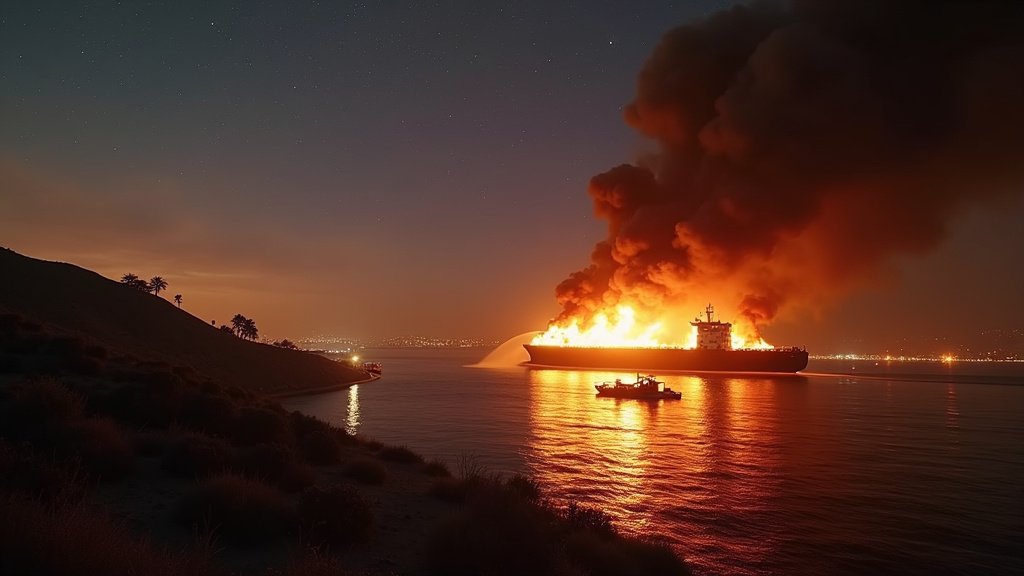SAN PEDRO, Calif. – A major emergency response concluded with the “substantially contained” blaze aboard the 1,100-foot container ship ONE Henry Hudson at the Port of Los Angeles, following a significant Cargo Ship Fire. The severe electrical fire, which erupted below deck on Friday evening and led to an explosion, prompted a temporary shelter-in-place order for surrounding communities due to concerns over hazardous materials. All 23 crew members were safely evacuated without injury from this dramatic cargo ship fire.
Cargo Ship Fire Erupts and Explosion Rocks Vessel
The incident began on Friday, November 21, 2025, at approximately 6:38 p.m. when the crew of the ONE Henry Hudson reported an electrical fire originating in the ship’s lower decks. The blaze quickly escalated, leading to an explosion near mid-deck around 8:00 p.m.. This detonation disrupted the vessel’s critical power systems, affecting lights and crane operations. The ship, operated by Ocean Network Express (ONE) and registered in Panama, had arrived in Los Angeles on November 19 after departing Tokyo, setting the stage for a concerning cargo ship fire.
Hazardous Materials in Cargo Ship Fire
Adding to the complexity of the firefighting efforts for the cargo ship fire, hazardous materials were identified in several cargo containers within the affected areas. This discovery necessitated the use of specialized protective gear, including self-contained breathing apparatus (SCBA), for all responding firefighters. The Los Angeles Fire Department (LAFD) and other agencies worked diligently to monitor air quality due to the potential for toxic smoke from the cargo ship fire.
Out of an abundance of caution, a shelter-in-place order was issued for the San Pedro and Wilmington neighborhoods late Friday night. Residents were advised to remain indoors with windows closed and ventilation systems off. Mayor Karen Bass of Los Angeles stated that city agencies were closely monitoring the situation and coordinating support for first responders during the cargo ship fire. The shelter-in-place order was lifted on Saturday morning, November 22, as air quality readings remained within normal ranges and the fire’s intensity diminished.
Massive Emergency Response to Cargo Ship Fire
The response to the “major emergency” involved a vast deployment of resources for the cargo ship fire. Over 100 firefighters, with numbers reaching nearly 200, from the LAFD, Long Beach Fire Department, Los Angeles County Fire Department, the U.S. Coast Guard, and Los Angeles Port Police were on scene. Specialized units, including hazardous materials teams, heavy rescue, and U.S. Coast Guard assets, worked in concert with numerous fireboats to combat the cargo ship fire. Fireboats continuously sprayed water to cool the ship’s hull and exterior, while thermal imaging aircraft provided critical oversight of the blaze.
Due to the challenging conditions, including inaccessible areas below deck and the risk of toxic fumes during this cargo ship fire, firefighting personnel were eventually ordered to withdraw from the ship’s interior. The suppression efforts then shifted to external attacks using master streams from a safe distance to contain the cargo ship fire.
Ship Relocated and Port Operations Resume After Cargo Ship Fire
In a coordinated overnight operation, the ONE Henry Hudson was undocked and moved out to sea to an anchorage approximately one mile offshore, near Angel’s Gate Lighthouse. This move was aimed at ensuring the safety of port operations and nearby communities following the cargo ship fire. By Saturday morning, with the fire substantially contained, port operations at the Port of Los Angeles began to resume, and the Vincent Thomas Bridge, which had been temporarily closed, reopened.
Investigation Underway for Cargo Ship Fire
While the immediate crisis of the cargo ship fire has been managed, investigators are now working to determine the precise cause of the electrical fire and subsequent explosion. The incident highlighted the inherent risks associated with cargo ship operations, including the transport of hazardous materials and the complexities of fighting fires in confined, multi-level vessel environments. The Port of Los Angeles, one of North America’s busiest seaports, confirmed that its operations, though temporarily impacted at four terminals, have returned to normal. The successful evacuation of all crew members and the containment of the blaze mark a critical, albeit challenging, chapter in the ongoing Los Angeles news cycle concerning this cargo ship fire.





